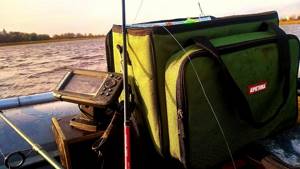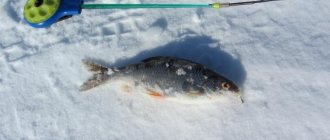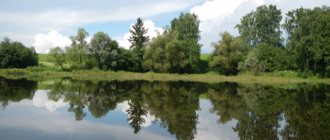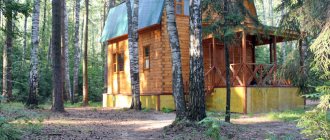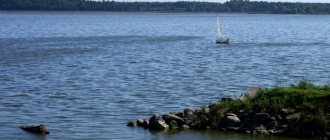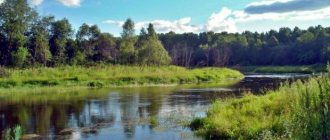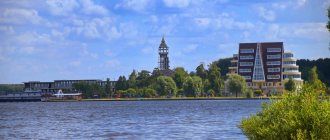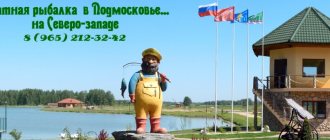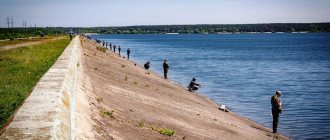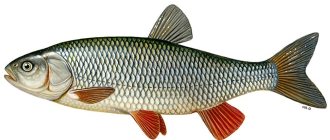Today, fishing on the Rybinsk Reservoir is one of the most favorite pastimes of Russian fishermen. Professionals and amateurs come here from all over Russia to catch a good catch and relax with their families. Reviews on thematic forums indicate that here you can catch fish of a wide variety of species, and you don’t have to use expensive gear or bait. Read more about fishing in Rybinsk and all its features in our article.
Characteristics of the reservoir and features of recreation
The Rybinsk Reservoir, in its characteristics, most closely resembles a shallow lake, the average depth of which is at 5.6 meters, and the maximum depth is 30 meters. The reservoir is of artificial origin and has a good food supply for most freshwater inhabitants. Also on the territory of the Rybinsk Reservoir you can find many recreation centers that offer their visitors to take advantage of all the necessary services: from renting gear to overnight accommodation. Most clients note that the service is not anything out of the ordinary, and the rooms are unlikely to be luxurious, but this is quite enough to relax after a tiring day. In addition, the price-quality ratio remains consistently good here. It is also impossible not to note the picturesque beauty and purity of the local nature, which attracts lovers of not only fishing, but also active recreation in the fresh air.
Varieties of freshwater inhabitants
The Rybinsk Reservoir is home to a wide variety of fish, which can be caught completely free of charge. This can be done conveniently both from the shore and from a boat. Typically, the catch of an ordinary fisherman includes:
- pike perch;
- roach;
- burbot;
- perch;
- pike;
- bream
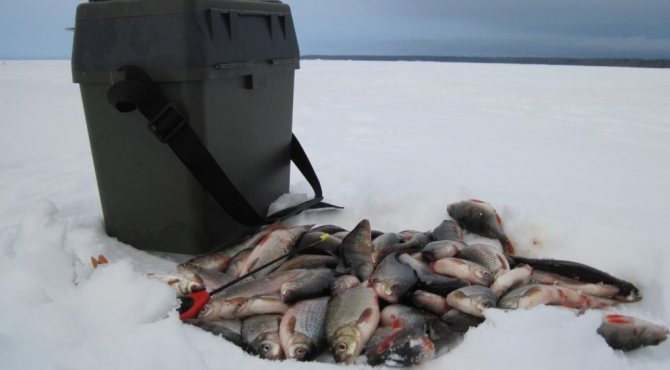
However, carp, carp, crucian carp and even grass carp are often found. Of course, to catch the rarest fish, you need not only to use the right bait, but also to know its habitat. We will talk about the most fishing places in the next section.
The most common fishing spots
Most recreation centers are concentrated in the southern part of the Rybinsk Reservoir, not far from some large city or village. This allows you to have regular customers from local residents, and not just tourists who come here a couple of times a year. Most common fishing spots are located near the following settlements:
- village of Protivye;
- Breytovo village;
- Gorelovo village;
- village of Baranovo.
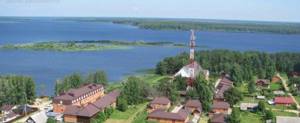
If you come to the Rybinsk Reservoir for the first time, then do not hesitate to ask local residents for advice on where is the best place to go fishing. As a rule, it is the local residents who know all the secrets of their reservoir and willingly share them with tourists in order to leave a good impression of themselves.
How to find a good place for fishing?
Have you decided to try wild fishing on the Rybinsk Reservoir? To do this, you will have to find the biting place yourself. To do this, you need to know the behavioral characteristics of some freshwater inhabitants. For example, carp prefer to settle near aquatic thickets, so it would be quite logical to look for bones near the reeds. But perch is a schooling fish, with seagulls constantly circling around it, so you can find a good place by looking for flocks of noisy birds.
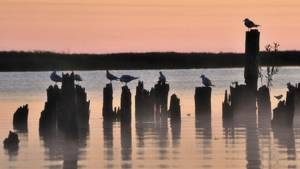
It is also necessary to take into account the topography of the bottom of the reservoir, since most large individuals prefer to settle at depth. Of course, a boat allows you to quickly and conveniently get to the depths and catch big fish afloat, but what to do if you don’t have a watercraft? Then a spinning rod and a map of the bottom of the reservoir will help you, which can be purchased at almost any fishing base. We look for a deeper place and throw the tackle there - simple and effective.
On Rybinsk snags
The giant Rybinsk Reservoir attracts tens of thousands of fishermen from all over Central Russia. It attracts not only with its size, although, as is known, the larger the body of water, the more impressive the trophies that live in it. This body of water is especially famous for its inexhaustibility of various fishing topics. Take, for example, the possibility of choosing fishing spots. Here you can find everything your heart desires - steep and gentle slopes, straight and winding edges, diverse shallow waters, rugged reed bays, mouths of tributaries, long underwater mounds and local “navels,” the remains of flooded buildings and various snags.
Today we will talk about snags themselves. Let me explain my point. The edge covered with submerged wood is still more interesting to us as a place with differences in depth, and snags often only mark the most “delicious” places on it. By snag itself we mean a large area of a fairly vast, almost homogeneous water area. In this case, the fish, and after it us, are attracted not by the insignificant relief, but by the snags. Such places can be found even with the help of the Rybinsk Reservoir navigation guide. True, I must say that there are few really interesting places on it. You will have to look for them yourself, and it’s up to the fisherman to decide which way to go. The simplest thing is to ask experienced Rybinsk fishermen, the more difficult thing is to study maps of the area before the flooding, and, finally, the most elementary, but also time-consuming way is to plow the expanses of the reservoir with an echo sounder. What is good about snag? After all, fishing in such places results in frequent bait hooks! Of course, an abundance of predatory fish. Moreover, these are long-lasting places that can bring trophies for almost the entire open water season. There is always a chance to catch something worthy on a snag. Of course, even on the most extensive of them, the bite cannot be constant. There is no such thing that every day you can come to some point and reap a rich harvest. More precisely, it happens, but only for a week or two, and then - downwards. After some time, there is a new surge in the activity of the predator - and again a decline. There may be several reasons for this - these are the characteristics of a particular season (the preferences of the predator in choosing a certain depth horizon are associated with them), and the weather conditions of a particular day, and the pressure of amateur fishermen should not be discounted either. Take, for example, the vast snags located along the border with the Darwin Nature Reserve between the villages of Breitoao and Prozorovo. Even on weekdays, a dozen or two boats above it are the norm rather than the exception. At the same time, everyone is catching something, that is, the fish are gradually knocked out. This is confirmed by catch statistics: they are usually richer in the first couple of weeks after the opening of the summer season. However, I repeat, there is a chance of a catch here any day! All fishermen in the middle zone are well aware of the concept of a thermocline. It is he who cuts off and removes from active circulation many popular snags on regulated reservoirs. On Rybinka, everything is somewhat different. Of course, there are exceptions, such as last year, when the thermocline on the reservoir remained firmly in place for several weeks. Usually this is a fleeting phenomenon. A few hot, calm days - and here it is, a freshly baked boundary between layers of warm and cold water. And then a cyclone comes, the winds raise a serious wave, and the water quickly mixes. So it turns out that a confident zander bite in mid-July at a depth of 7-8 m is quite common. In the snagged areas of the reservoir you can find a wide variety of predatory fish. However, it is better to target the most abundant representatives - pike perch and pike perch. Bersh often form joint flocks with them, and they are quite large. You will definitely catch pike along the way, but it is still better to perceive it only as bycatch. As exotics, burbot or catfish bites are possible. Occasionally, a bream that decides to prey is caught on a hook. In snags, pike perch and pike perch are usually found separately. The fanged fish clearly prefers greater depth and a hard bottom, while its smaller relative is simpler in its claims. I know one snag that smoothly descends into the depths. So: there, a kind of border between predators is located at a depth of 4-4.5 m. Above is perch, below is pike perch. Author: A. Pokhlebkin
Warm summer
Fishing on the Rybinsk Reservoir in summer is a fairly popular activity among local residents. Most visiting fishermen prefer to come to the reservoir in autumn or winter. But in vain! After all, it is in the summer that you can catch very large representatives of carp, perch, and, if you’re lucky, even a large pike. The best baits for this time of year are worms, corn and maggots. From the gear you can use both regular float gear and spinning rod.
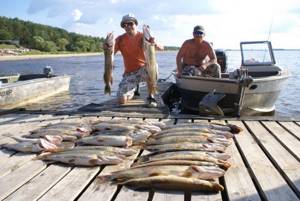
Judging by the reviews of anglers, in a few hours of such fishing you can catch from 5 to 30 kilograms of fish, and individuals whose weight exceeds 1 kilogram are far from uncommon. In general, if you want to enjoy your vacation, then fishing in the summer at the Rybinsk Reservoir will come in handy. Almost complete absence of tourists and a good bite - what else is needed for fishing happiness?
Fishing bases
Fishing on the Rybinsk Reservoir is free.
For the convenience of fishermen and the possibility of combining fishing with recreation and other entertainment, a large number of fishing bases are located on the coast of the reservoir, which offer all the necessary services for comfortable leisure. Next, we will consider in detail the conditions offered by the Sokol and Rybinsky Trophy bases.
Falcon
The recreation center is located in the village of Prozorovo, Yaroslavl region, not far from the Darwin Nature Reserve. The base is located on the shore of the Rybinsk Reservoir, surrounded by young birch and pine trees. There is clean air, beautiful scenery and excellent fishing.
Guests are accommodated in comfortable cottages that can accommodate up to six people.
The rooms have:
- Bathroom.
- TV and satellite TV.
- Equipped kitchen.
Sokol welcomes vacationers at any time of the year.
The base has an amazing location, as there is a sandy beach 50 meters away and a forest 100 meters away.
Here you can not only fish, but also:
- pick mushrooms and berries;
- hunt game;
- hunts a bird.
The recreation center will definitely appeal to lovers of fishing and quiet family holidays in unity with nature.
Autumn fishing
The opening season for autumn fishing in Rybinsk begins in mid-September and lasts until the first ice appears on the reservoir (usually at the end of November). For most anglers, this time of year is of interest due to the large concentrations of pike perch and bream near the shores. Also in the fall you can catch quite large specimens of pike, since it is at this time of year that the fish begin to gain weight for wintering.
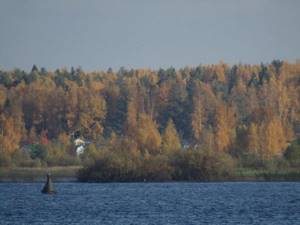
From the list of tackles, it is best to give preference to float tackles or donks with a fishing line thickness of at least 0.4 millimeters. For bait, a regular earthworm or any imitation bait works very well. The most fishing places are located in the vicinity of the city of Vesyegonsk and near the village of Breytovo.
Fishing on the Ukhra River
The Ukhra River is one of the most favorite places for fishermen. There are enough fish here and the bite is excellent. A variety of gear is used.
From the beginning of June, rivers are of interest only to spinning anglers, because spawned fish rush into the sea or sit secluded in the thickets, from where it is almost impossible to lure them out. In Uhra, perch begins to actively behave at this time. In the last summer month, Ukhra is generous with pike. You will have to work hard with your catch, but the river will certainly thank you. They say there are trophies weighing more than 5 kg here.

With the coming of spring
Spring fishing in Rybinsk follows certain rules, since at this time of year it is prohibited to catch most species of freshwater inhabitants that go out to spawn. However, you can continue to catch roach, pike perch and pike freely using a float tackle or spinning rod.
Spring fishing begins when the first ice melts from the reservoir. At this time of year you need to be extremely careful, because near the shores the ice may seem quite strong, but at a distance of ten meters from the shore it does not exceed a couple of centimeters in thickness. Therefore, you should not risk your health and drill holes further than 10 meters from land.
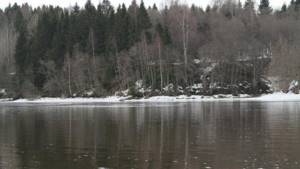
In May days, you can catch quite large individuals of perch, since after spawning it begins to actively store fat. Bersch also bites quite well on boiled corn, but there are incredibly few places with this rare species of fish. To catch bersh, you need to find a deep enough place and swim up in a boat, but so that there is a sufficient amount of algae at the bottom.
Travel around Karelia
Commercial fish distribution maps are compiled on the basis of average monthly data. For convenience, the entire reservoir is divided into conventional squares with sides of 5 km. The squares are shaded depending on the density of aggregations found in a given area and show what kind of catch a link of fishermen can get here in a month on the order of 40 nets selected for the primary catch of this fish and set taking into account the characteristics of the area. Each distribution scheme is accompanied by a description of the mass movements of fish during a given period.
On the diagrams, the dotted line indicates the flooded river beds and floodplain reservoirs, and the thin solid line indicates the boundaries of the drainage zone when the level is drawn down 4 meters from its normal state in June - July (when filled to the design level). Squares in which there were no stable catches or, in rare cases, where fishing was not carried out in the required volume, were left unshaded. The latter took place primarily in the coastal waters of the Darwin Nature Reserve (northern coast of the reservoir), in the Korotov Bay of the Sheksninsky Reach and in hard-to-reach areas of peat rafts.
For blue bream and roach, which do not make large migrations or their migrations coincide with those already described for other species, in order to avoid repetition, we provide distribution schemes only for large periods (spring, summer, autumn). The autumn distribution pattern for these fish is valid for most of the winter. Therefore, their winter distribution is not specifically considered.
When compiling the fishery atlas, ten years of materials on a comprehensive study of the Rybinsk Reservoir, collected by the Institute of Inland Water Biology of the USSR Academy of Sciences and other organizations, and data from fisheries statistics were used.
EXPLANATION FOR THE MAP DIAGRAMS
Rice. 8. Distribution of water masses in May.
Horizontal and vertical shading mark areas affected by spring flood waters. Areas of the central part of the reservoir with preserved winter water are shaded.
Rice. 9. Distribution of water masses at the beginning of summer.
Vertical shading marks areas with preserved spring flood water. The checkered shading indicates winter water in the center of the reservoir, and summer water in the river reaches, which is identical in electrical conductivity and some other properties.
Rice. 10. Distribution of water masses in late autumn.
Hatching with an oblique cell indicates the distribution of water masses in the central part of the reservoir and the Sheksna River, and with a straight cell - the waters of Mologa and the Volga.
Rice. 11. Distribution of water masses in winter.
The areas of water masses in the central part of the reservoir are shaded with an oblique cell. Straight boxes mark zones of removal of river water masses.
Rice. 12-15. Water temperature.
The lines (isotherms) in the figures limit areas with the same water temperature, and the numbers for each of them indicate its value in degrees.
Rice. 16. Oxygen content in water in winter.
Areas of the reservoir with an acute lack of oxygen (less than 2 mg per liter of water) are shaded black. Fish kills are regularly observed here.
Shading with an oblique cell means that there is very little oxygen here (from 2 to 4 mg per liter). The fish tends to leave this zone.
Areas where a liter of water contains from 4 to 7 mg of dissolved oxygen and the wintering conditions for most fish species are satisfactory are shaded with straight lines.
Vertical shading indicates areas of the reservoir with good conditions (7-10 mg of oxygen per liter of water), and horizontal shading indicates the best wintering areas for fish in terms of gas conditions (oxygen in water is more than 10 mg per liter).
Rice. 17-18. Benthos distribution.
The biomass (quantity in grams per 1 square meter of bottom area) of bottom invertebrate animals (benthos) feeding fish in different areas of the Rybinsk Reservoir is indicated.
Rice. 19-57. Distribution of fish in different months and seasons of the year.
Fishing maps of the distribution of bream (Fig. 19-26), pike perch (Fig. 27-34), pike (Fig. 35-42), burbot (Fig. 43-50), blue bream (Fig. 51-54) and roach ( Fig. 55-57) are compiled on the basis of average monthly data.
For convenience, the entire reservoir is divided into conventional squares with sides of 5 km and an area of 25 square meters. km.
The squares are shaded depending on the density of fish aggregations found in a given area and show what kind of catch a link of fishermen can get here in a month on the order of 40 nets selected for the primary catch of this fish and set taking into account the characteristics of the area.
Areas of the reservoir in which there were no stable catches or where control fishing was not carried out are left unshaded.
Winter fishing
Perhaps the most popular time of year for fishing in Rybinsk is winter. It is during the winter season that most ice fishing enthusiasts come here to catch large specimens of roach and pike. Sometimes there are so many tourists that you have to spend half an hour looking for a place where you can drill a hole and slowly start fishing. For this, it is best to use bottom tackle and bloodworm larvae. However, in winter, underwater inhabitants actively bite on almost any bait.
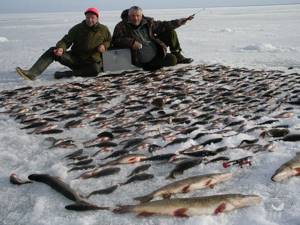
Judging by the reviews of most fishermen, the most successful place for drilling holes is coastal waters. Firstly, there are really a lot of fish in this area, since they prefer to eat algae. Secondly, the ice at a depth exceeds 60 centimeters in thickness, so it will be extremely difficult to drill through it. And with the help of modern instruments, you can not only explore the depths, but also the presence of underwater inhabitants in a particular place. By the way, you can rent such a device at almost any fishing base.
Some fishermen leave reports on fishing on the Rybinsk Reservoir on thematic forums. Bases, rental of gear and swimming equipment, good bite, pleasant atmosphere - this is what fishermen note in their laudatory reviews. It is worth noting that such statements are not at all exaggerated. This body of water has always been famous for the large number and variety of freshwater inhabitants, and the service of local fishing bases has been unobtrusive and reasonable prices. This is why fishing and recreation in Rybinsk are so popular.
And who is opposing the netters at the Rybinsk Reservoir?
And in theory, this structure should be the “ Fish Protection ” together with the police, and now, another shocking figure:
The area of the Rybinsk Reservoir is 4,580 km, and if in Soviet times, according to official data, about 100 inspectors tried to control this area, then today, the number of Fisheries Protection
ATTENTION!!!! COMPLETES 9 PEOPLE!!!
JUST THINK ABOUT IT!
What can these people who live and work “on the water” and receive 3 kopecks for their work do with such a vast territory? What can they control there?
It is for this and a number of other reasons that the breeding stock of pike perch, asp, bream and pike are under threat, and it is because of the bungling of both local and capital officials that Rybinka is becoming very small in the catches.
Those 9 poor inspectors are simply not able to stop illegal fishing, including because of the material and technical base, which must be head and shoulders above any poacher or arrogant fisherman, who, in addition to the norm, does not hesitate to send several tons of beautiful, fresh fish past the scales of regulatory authorities.
